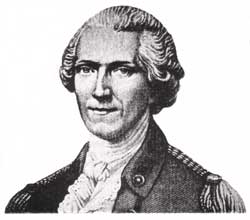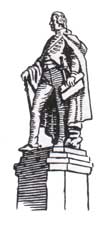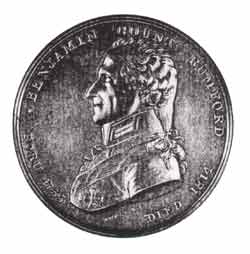|

|
COUNT RUMFORD
SIR BENJAMIN THOMPSON
1753 -1814
World-renowned Soldier, Statesman, Inventor &
Scientist |
|

National Historic Landmark |
THE LIFE AND LEGEND OF COUNT RUMFORD
Born Woburn, Massachusetts
Controversy was as much a part of Rumford’s
life as was brilliance and achievement, so it’s not easy to picture this
flamboyant figure in the simple setting of the farmhouse on Elm Street
that was his birthplace. But that is where life began for Sir Benjamin
Thompson at the home of his grandfather on March 26, 1753.
Perhaps it was John Fowle, the Harvard
educated village teacher who first noticed signs of talent in young
Thompson - his skill with mechanical devices, his almost faultless command
of language and grammar before his thirteenth year. These skills later won
him the right, along with friend and neighbor Loammi Baldwin (regarded by
many as America’s first engineer), to attend Professor John Winthrop’s
lectures on science at Harvard. |
|
Early Career |
Apprenticeships in the
importing trade and the study of medicine, too, absorbed much of his young
life until at the age of 19 he became a schoolmaster in Concord (earlier
called Rumford) N.H. There he met and married a wealthy widow, Mrs. Sarah
Rolf, who was also the daughter of Reverend Timothy Walker. In this
position of influence, young Thompson met Governor Wentworth of New
Hampshire who was impressed enough to name him Major in the 2nd Provincial
Regiment. |
|
Soldier |
This commission,
awarded to him over older men, and his continued contacts with influential
British officers, such as General Gage in Boston, set him in the center of
controversy. In 1774 a committee of Concord citizens charged him with
“being unfriendly to the cause of liberty.” Though acquitted, he felt
the atmosphere so inimical that he returned to Woburn and to the home of
his mother where he was joined by his wife and infant daughter. But the
controversy stalked him and similar charges were brought against him after
the Battles of Lexington and Concord. Again he was released after no
evidence was produced. But this time he left and found his way to Boston
and an English ship during the British evacuation of March 1776. |
|
Inventor |
In England his
scientific career prospered. While serving in the Government Colonial
Office his scientific study and experiments, particularly with gunpowder,
were so successful that he was elected in 1779, at the age of 26, to the
prestigious Royal Society. In 1783, through the intercession of Prince
Maximilian (whom he met while traveling in Strasbourg, France), he was
invited by the Elector of Bavaria to accept a high post as a
military/civilian advisor.
With the blessing of his English sponsors, Sir
Benjamin accepted and was made Major-General of Calvary and Privy
Councelor of state, Bavaria. Thompson then turned his talents to sound
reform. |
|

|
Statesman |
The Army, poorly paid
and ill-clothed and -equipped, was in a state of low morale. The streets
of Munich were crowded with unemployed beggars. The resourceful Thompson
offered the beggars the useful employment of making uniforms for the Army.
To the Army he offered higher pay, free education for soldiers and their
children, and important public works projects to occupy time not consumed
in training.
One of these projects was the now famous English
Gardens devised by Thompson to reclaim a large wasteland just outside the
city of Munich. This wooded park with lakes, patios, and drives still
exists as one of the city’s major recreational areas.
In 1791 Sir Benjamin Thompson was named a Count
of the Holy Roman Empire. He assumed the title of Count Rumford after the
New Hampshire town where his spectacular career began. |
|
Honored |
A bronze statue of
Count Rumford commissioned by the king of Bavaria in 1867 stands on
Maximilian Strasse as testimony to the gratitude of the citizens of
Munich. An exact replica, cast in the same foundry, was donated to the
citizens of Woburn in 1900 by Marshall Tidd. It stands on the grounds |
|

|
THE RUMFORD MEDAL
Count Rumford in 1796 gave $5,000 each to the Royal Society of Great
Britain and to the American Academy of Arts and Sciences to award medals
every two years for outstanding scientific research on heat or light.
Among those who have received the Rumford Medal from the Royal Society are
Humphry Davy, Michael Faraday, Louis Pasteur, James Maxwell, and John
Tyndall. Among those who have received the award from the American Academy
of Arts and Sciences are Josiah Gibbs, Thomas Edison, Albert Michelson,
Irving Langmuir, Arthur Compton, Karl Compton, Enrico Fermi, and Edwin
Land. The residue of this estate was left to Harvard University with which
the present Rumford Professorship was established. |
|
RUMFORD
HISTORICAL
ASSOCIATION |
The Rumford Historical Association, 90 Elm
Street, Woburn, Massachusetts was founded March 26, 1877, for the purpose
of maintaining the birthplace of Benjamin Thompson as a site of historic
interest. The birthplace contains reconstructed models of Count Rumford’s
scientific experiments and inventions. Also on display is a copy of a
portrait of Count Rumford by Gainsborough and a library of Rumford
biographies and essays.
This booklet prepared by the Woburn Historical Commission, MCMLXXV |



